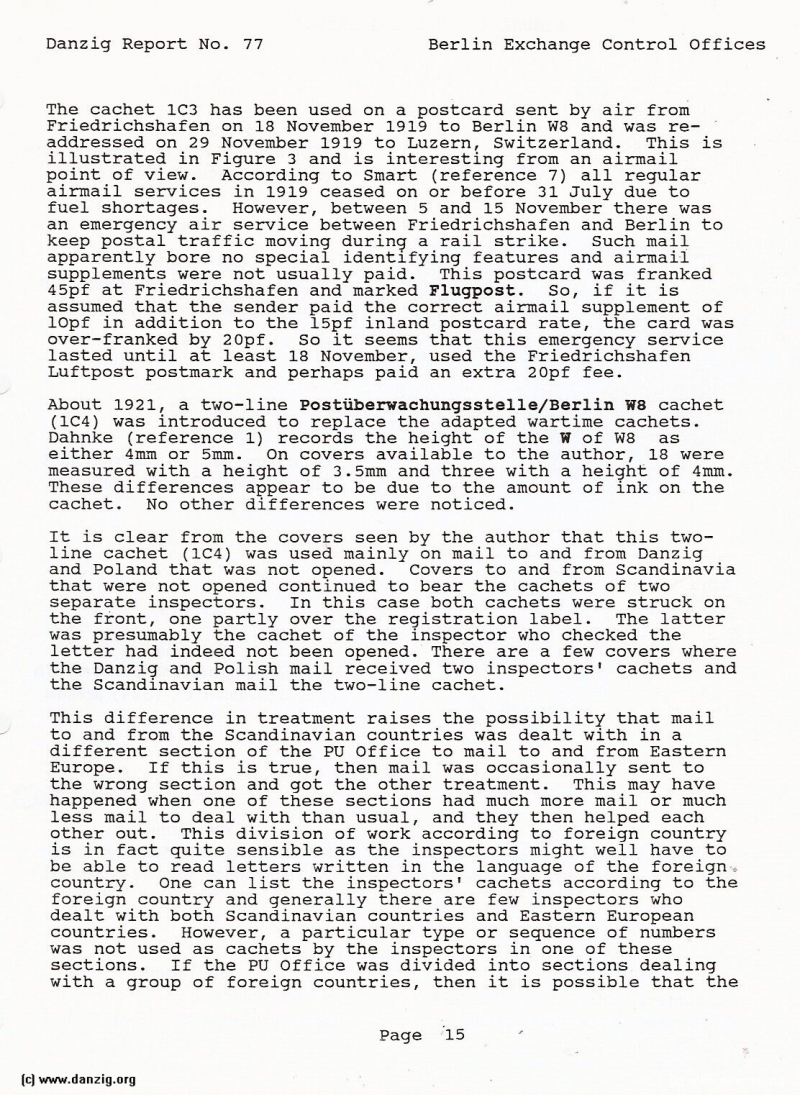
The cachet lC3 has been used on a postcard sent by air from Friedrichshafen on 18 November 1919 to Berlin W8 and was re— addressed on 29 November 1919 to Luzern, Switzerland. This is illustrated in Figure 3 and is interesting from an airmail point of view. According to Smart (reference 7) all regular airmail services in 1919 ceased on or before 31 July due to fuel shortages. However, between 5 and 15 November there was an emergency air service between Friedrichshafen and Berlin to keep postal traffic moving dunn9 a rail strike. Such mail apparently bore no special identifying features and airmail supplements were not usually paid. This postcard was franked 45pf at Friedrichshafen and marked Flugpost. So, if it is assumed that the sender paid the correct airmail supplement of lOpf in addition to the l5pf inland postcard rate, the card was over-franked by 2Opf. So it seems that this emergency service lasted until at least 18 November, used the Friedrichshafen Luftpost postmark and perhaps paid an extra 2Opf fee.
About 1921, a two—line Postuberwachungsstelle/Berlin W8 cachet (1C4) was introduced to replace the adapted wartime cachets. Dahnlce (reference 1) records the height of the W of W8 as either 4mm or 5mm. On covers available to the author, 18 were measured with a height of 3.5mm and three with a height of 4mm. These differences appear to be due to the amount of ink on the cachet. No other differences were noticed.
It is clear from the covers seen by the author that this two— line cachet (lC4) was used mainly on mail to and from Danzig and Poland that was not opened. Covers to and from Scandinavia that were not opened continued to bear the cachets of two separate inspectors. In this case both cachets were struck on the front, one partly over the registration label. The latter was presumably the cachet of the inspector who checked the letter had indeed not been opened. There are a few covers where the Danzig and Polish mail received two inspectors’ cachets and the Scandinavian mail the two-line cachet.
This difference in treatment raises the possibility that mail to and from the Scandinavian countries was dealt with in a different section of the PU Office to mail to and from Eastern Europe. If this is true, then mail was occasionally sent to the wrong section and got the other treatment. This may have happened when one of these sections had much more mail or much less mail to deal with than usual, and they then helped each other out. This division of work according to foreign country is in fact quite sensible as the inspectors might well have to be able to read letters written in the language of the foreign country. One can list the inspectors’ cachets according to the foreign country and generally there are few inspectors who dealt with both Scandinavian countries and Eastern European countries. However, a particular type or sequence of numbers was not used as cachets by the inspectors in one of these sections. If the PU Office was divided into sections dealing with a group of foreign countries, then it is possible that the
Danzig Report Vol. 1 - Nr. 77 - October - November - December - 1992, Page 15.
Hits: 3909
Added: 03/07/2015
Copyright: 2025 Danzig.org

